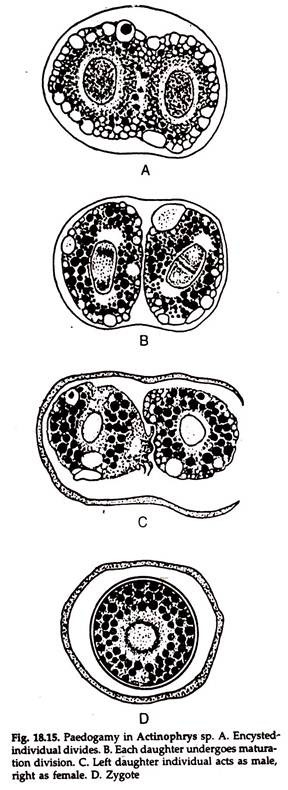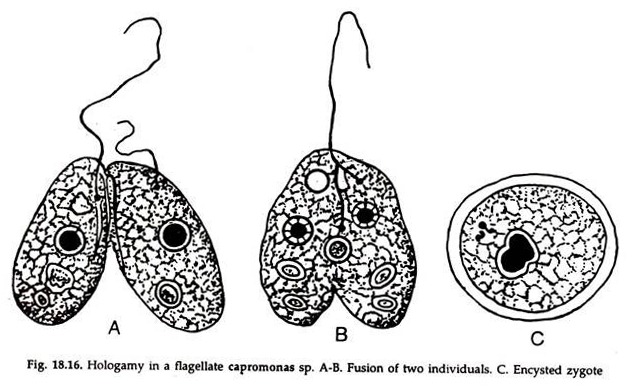In this article we will discuss about the asexual and sexual modes of reproduction in protozoa, explained with the help of suitable diagrams.
Asexual Reproduction in Protozoa:
The mode of reproduction in which there is no union of gametes. In such a case, only one animal can produce new individuals. Protozoa usually reproduces asexually by binary fission and multiple fission.
I. Binary Fission:
The animal divides and two individuals are produced from one:
1. The micronucleus divides into two by a simplified form of mitosis.
ADVERTISEMENTS:
2. The macronucleus divides into two by amitosis.
3. The cytoplasm divides into two equal halves by a constriction.
4. The daughter individuals can reconstruct the wanting structures which it does not obtain from the parent. Asymmetrical structures like gullet, peristome of Paramoecim cannot be equally shared by both the daughter individuals.
Binary fission is again of three types:
ADVERTISEMENTS:
a. Transverse fission. The animal divides transversely into two. Examples: Amoeba, Paramoecium, etc.
b. Longitudinal fission. The animal splits into two along the long axis of the body. Examples: Euglena, Vorticella, etc.
c. Oblique binary fission. The plane of fission is oblique. Examples: Dinoflagellata, Ceratium, Cochliodinium,. etc.
II. Multiple Fission or Sporulation:
Many individuals are produced from one at a time. Examples: Some Amoebae, Euglena, Polystomella, etc.
ADVERTISEMENTS:
1. The animal becomes encysted, the nucleus divides repeatedly and a large number of minute daughter nuclei are produced.
2. The cytoplasm fragments and a small bit of it surrounds each daughter nucleus and, thus, many minute animals are formed.
3. Under favourable circumstances the cyst bursts and these small animals come out and grow to the adult stage.
Multiple fission is common in sarcomastigophorans and apicomplexans. The process has been differently named according to the period and time of occurrence.
Following types of multiple fission are found in protozoa:
a. Gamogony:
Products are gametes. Examples: Monocytes.
b. Scizogony or agamogony occurs in asexual stages:
The resulting individuals are known as agametes or merozoites. Example: Plasmodium.
ADVERTISEMENTS:
c. Sporogony:
It occurs following sexual fusion. The products are surrounded by a cyst or a resistant covering and termed as spores. Motile spores are known as swarmer’s or swarmospores.
The swarmers are of two types:
i. Flagellospore. Spores bearing flagella.
ii. Pseudopodiospore or amoebospore. Spores beaning pseudopodia.
III. Plasmotomy:
The multinucleate individual divides into many small multinucleate offspring’s by simple division of cytoplasm independent of nuclear division. The daughter individuals regain the normal size and the number of nuclei is restored by further nuclear division.
IV. Budding:
New individuals are produced by separation of a portion of the cytoplasm of the parent organism with a daughter nucleus. It may be simple or multiple, exogenous or endogenous. Budding is common in suctorians. Examples: Noctiluca, Tokophrya, etc.
Sexual Reproduction in Protozoa:
The modes of reproduction in which two gametes unite to form a new individual is known as sexual reproduction. The two units (male and female gametes) from two separate individuals unite by fusion of their cytoplasm, followed by the union of their nuclei. Most protists (protozoa) can continue to live, multiplying asexually for prolonged periods and may undergo sexual reproduction only at irregular intervals.
However, there are many protozoans in which sexual reproduction is of regular occurrence. Sexual reproduction involves meiotic division reducing the chromosomes to haploid number. In majority, reduction division occurs shortly before syngamy. This is called gametic meiosis, in which gametes become haploid.
But in some protozoans reduction division occurs in one of the subsequent divisions after formation of zygote. This is termed as zygotic meiosis, in which only zygote is diploid but rest of the life cycle is haploid. Of different types of sexual reproduction in protozoans syngamy, conjugation, automyxis are important.
I. Syngamy or Sexual Fusion:
Syngamy is the complete and permanent union or fusion of two specialised protozoan individuals or gametes resulting in the formation of a fertilized cell or zygote or oospore. The nuclei of the gametes fuse to form the zygote nucleus or synkaryon. The zygotes develop into adult, either directly or through encystment and fission of various types.
Depending upon the degree of differentiation of the fusing gametes syngamy may be of the following types:
a. Autogamy:
The gametes derived from the same parent cell fuse. Examples: Actinophrys, Actinosphaerium, Paramoecium aurelia, etc.
b. Paedogamy:
The fusing individuals are young. Example: Actinophrys (Fig. 18.15).
c. Hologamy:
The two mature individuals behave as gametes and fuse. Example: Copromonas (18.16).
d. Merogamy:
The uniting individuals are smaller than the ordinary vegetative individuals, called merogametes.
e. Isogamy:
Union of the gametes of similar size and shape. The isogametes are produced by multiple or repeated binary fission. Isogamy has been reported in Foraminifera (Elphidium), Phytomonadina (Chlamydomonas, Copromonas) and Gregarinida (Monocystis).
f. Anisogamy:
The two fusing gametes differ in size, shape and behaviour. The gametes are termed as heterogametes or anisogametes and their fusion is known as anisogamy or heterogamy. The formation of morphologically different gametes, is the first indication of sex differentiation in Protozoa.
The smaller gametes, the microgametes, or male gametes, are active, motile, generally flagellated and more numerous. They are produced by multiple or repeated fissions.
The fusion of two microgametes is called Micro-gamy. Example: Foraminifera, Arcella, etc. The larger gametes, macrogametes, are immotile, voluminous, and referred to as female gametes. The fusion of two macrogametes is called Macro-gamy. Examples: Plasmodium, Eimeria, Volvox, etc.
The syngamy brings about a combination of two different lines of hereditary characters. It increases the external differences in offspring’s. It also renews the vigour which is lost due to repeated binary fissions. The fusion of two nuclei initiates the development of eggs.
II. Conjugation:
The conjugation is the temporary union of two mating types of individuals of the same species to facilitate exchange of nuclear materials. They retain their distinct individuality and separate out after nuclear exchange. The pairing gametes are known as conjugants. The conjugants may be either isogamous (Paramecium) or anisogamous (Vorticella).
Conjugation is considered to be an episode in reproduction and not a mode of multiplication. In conjugation (i) reorganization of a fresh meganucleus occurs to accelerate the metabolic activities, (ii) rejuvenation and revival of lost vigour, (iii) new nuclear combinations and new hereditary combinations arise.
III. Automixis:
Automixis is the fusion of two gametic nuclei originating by the division of the single nucleus of an individual.
Automixis may be of the following types:
a. Autogamy:
The fusing nuclei come from the same cell as in Paramecium. All the steps in nuclear changes are similar to conjugation but the union occurs between the pronuclei of the same individual.
b. Paedogamy:
The fusion occurs between two nuclei coming from two different cells of a parent. A single organism encysts and then divides into two or more gametocytes. The nuclei of these gametocytes undergo meiosis and the gametes thus produced unite in pairs forming the zygotes. Examples: Actinosphaerium, Actinophrys, myxosporidians, etc.
c. Cytogamy:
In a number of species of Paramoecium the two individuals fuse with their oral surfaces. The nuclear changes occur as in conjugation but no nuclear exchange occurs. The two gametic nuclei in each individual fuse to form synkaryon. Cytogamy is said to be intermediate between conjugation and autogamy.
d. Hemixis:
Other modes of reproduction:
1. Plasmogamy:
Two or more individuals may fuse by their cytoplasm to form a plasmodium and separate out unchanged with their distinct nuclei. This sexual phenomenon is known as Plasmogamy and occurs in certain Rhizopoda and Mycetozoa.
2. Regeneration:
The regeneration and replacement of lost parts among free-living and few parasitic protists is widespread. A proper proportion of cytoplasm and nucleus can regenerate into an entire individual.
3. Parthenogenesis:
The gametes which fail to fertilize start their development parthenogenetically. Examples: Actinophrys, Chlamydomonas, etc.

